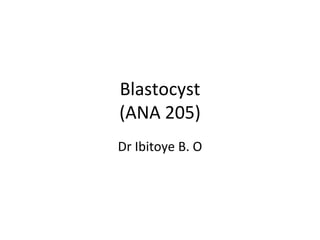
Blastocyst ANA 205.ppt
- 1. Blastocyst (ANA 205) Dr Ibitoye B. O
- 2. Follicle Maturation and Ovulation Oocytes ~2 million at birth ~40,000 at puberty ~400 ovulated over lifetime Leutinizing Hormone surge (from pituitary gland) causes changes in tissues and within follicle: • Swelling within follicle due to increased hyaluronan • Matrix metalloproteinases degrade surrounding tissue causing rupture of follicle Egg and surrounding cells (corona radiata) ejected into peritoneum Corona radiata provides bulk to facilitate capture of egg.
- 3. Corona radiata Zona pellucida (ZP-1, -2, and -3) Cortical granules The egg (and corona radiata) at ovulation
- 4. Transport through the oviduct At around the midpoint of the menstrual cycle (~day 14), a single egg is ovulated and swept into the oviduct. Fertilization usually occurs in the ampulla of the oviduct within 24 hrs. of ovulation. Series of cleavage and differentiation events results in the formation of a blastocyst by the 4th embryonic day. Inner cell mass generates embryonic tissues Outer trophectoderm generates placental tissues Implantation into the uterine wall occurs ~6th embryonic day (day 20 of the menstrual cycle)
- 5. Embryologists Fertilization age: moment of fertilization is dO Division of pregnancy corresponding to development: 0-3 weeks –early development 3-8 weeks –embryonic period (organogenesis) 8 wks-term –fetal period Total gestation time = 38 weeks Clinicians Menstrual age: last menses is dO Division of pregnancy into trimesters Total gestation time = 40 weeks Timing of pregnancy
- 6. Week 1: days 1-6 • Fertilization, day 1 • Cleavage, day 2-3 • Compaction, day 3 • Formation of blastocyst, day 4 • Ends with implantation, day 6
- 7. Fertilized egg 2 polar bodies 2 pronuclei Day 1 0.1 mm Fertilized egg (zygote)
- 8. Cleavage Cleavage = cell division Goals: grow unicellular zygote to multicellular embryo. Divisions are slow: 12 - 24h ea No growth of the embryo- stays at ~100 um in diameter Divisions are not synchronous Cleavage begins about 24h after pronuclear fusion
- 9. 2 Cell Stage Individual cells = blastomeres Mitotic divisions maintain 2N (diploid) complement Cells become smaller Blastomeres are equivalent (aka totipotent).
- 10. 4 cell; second cleavage 4 equivalent blastomeres Still in zona pellucida
- 12. Embryo undergoes compaction after 8-cell stage: first differentiation of embryonic lineages Caused by increased cell-cell adhesion Cells that are forced to the outside of the morula are destined to become trophoblast--cells that will form placenta The inner cells will form the embryo proper and are called the inner cell mass (ICM).
- 13. Formation of the blastocyst Sodium channels appear on the surface of the outer trophoblast cells; sodium and water are pumped into the forming blastocoele. Note that the embryo is still contained in the zona pellucida.
- 15. Early blastocyst Day 3 Later blastocyst Day 5 blastocoele inner cell mass
- 16. Monozygotic twinning typically occurs during cleavage/blastocyst stages
- 17. “Hatching” of the blastocyst: preparation for implantation Hatching of the embryo from the zona pellucida occurs just prior to implantation. Occasionally, the inability to hatch results in infertility, and premature hatching can result in abnormal implantation in the uterine tube.
- 18. Ectopic Implantation Implantation somewhere other than upper portion of uterus “Rupture” can lead to life- threatening hemorrhage
- 19. Tubal pregnancy
- 20. Week 2: days 7-14 implantation • Implanted embryo becomes more deeply embedded in endometrium • Further development of trophoblast into placenta • Development of a bi-laminar embryo, amniotic cavity, and yolk sac.
- 21. Implantation and placentation (day 8) Trophoblast further differentiates and invades maternal tissues – Cytotrophoblast: stem cell population – Syncytiotrophoblast: invasive fused cells (syncytium) derived from cytotrophoblast – Breaks maternal capillaries, trophoblastic lacunae fill with maternal blood Inner cell mass divides into epiblast and hypoblast: – Epiblast contributes to forming the overlying amniotic membrane and amniotic cavity – Hypoblast contributes to forming the underlying yolk sac.
- 22. Implantation and placentation (day 9) Trophoblast further differentiates and invades maternal tissues – Cytotrophoblast: stem cell population – Syncytiotrophoblast: invasive fused cells (syncytium) derived from cytotrophoblast – Breaks maternal capillaries, trophoblastic lacunae fill with maternal blood Inner cell mass divides into epiblast and hypoblast: – Epiblast contributes to forming the overlying amniotic membrane and amniotic cavity – Hypoblast contributes to forming the underlying yolk sac.
- 23. Implantation and placentation (day 12) Trophoblast further differentiates and invades maternal tissues – Cytotrophoblast: stem cell population – Syncytiotrophoblast: invasive fused cells (syncytium) derived from cytotrophoblast – Breaks maternal capillaries, trophoblastic lacunae fill with maternal blood Inner cell mass divides into epiblast and hypoblast: – Epiblast contributes to forming the overlying amniotic membrane and amniotic cavity – Hypoblast contributes to forming the underlying yolk sac.
- 24. Implantation and placentation (day 13) Trophoblast further differentiates and invades maternal tissues – Cytotrophoblast: stem cell population – Syncytiotrophoblast: invasive fused cells (syncytium) derived from cytotrophoblast – Breaks maternal capillaries, trophoblastic lacunae fill with maternal blood Inner cell mass divides into epiblast and hypoblast: – Epiblast contributes to forming the overlying amniotic membrane and amniotic cavity – Hypoblast contributes to forming the underlying yolk sac.
- 25. Week 3: Days 14-21 • Two layer germ disc • Primitive streak forms • Gastrulation forms tri-laminar embryo • Neural induction • Left-right asymmetry • 0.4mm - 2.0mm
- 27. •THANK YOU